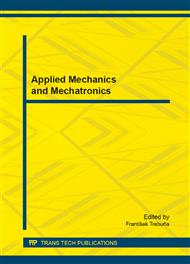p.370
p.376
p.387
p.395
p.400
p.405
p.412
p.416
p.424
Application of Differential Equations to Calculations of Large Deformations of Structural Members
Abstract:
The article discusses the application of differential equations to solve large deformations of the designed slender structural elements. The structural element under design has a variable circular cross-section in longitudinal direction. It is made of a composite material based on carbon fiber and is capable of large deformations. In the solution it was necessary to consider the nonlinear deformation theory, which led to the solution of a nonlinear differential equation of second order. The creation of the differential equation describing the line of elastic deformation of a significantly curved structural element required the formulation of input equations and boundary conditions for its solution. The results obtained by means of a differential equation were compared with the numerical solution applying the finite element method. The solution presented and methodology can be used for practical application in the engineering design of fishing rods.
Info:
Periodical:
Pages:
400-404
Citation:
Online since:
August 2014
Authors:
Price:
Сopyright:
© 2014 Trans Tech Publications Ltd. All Rights Reserved
Share:
Citation:


